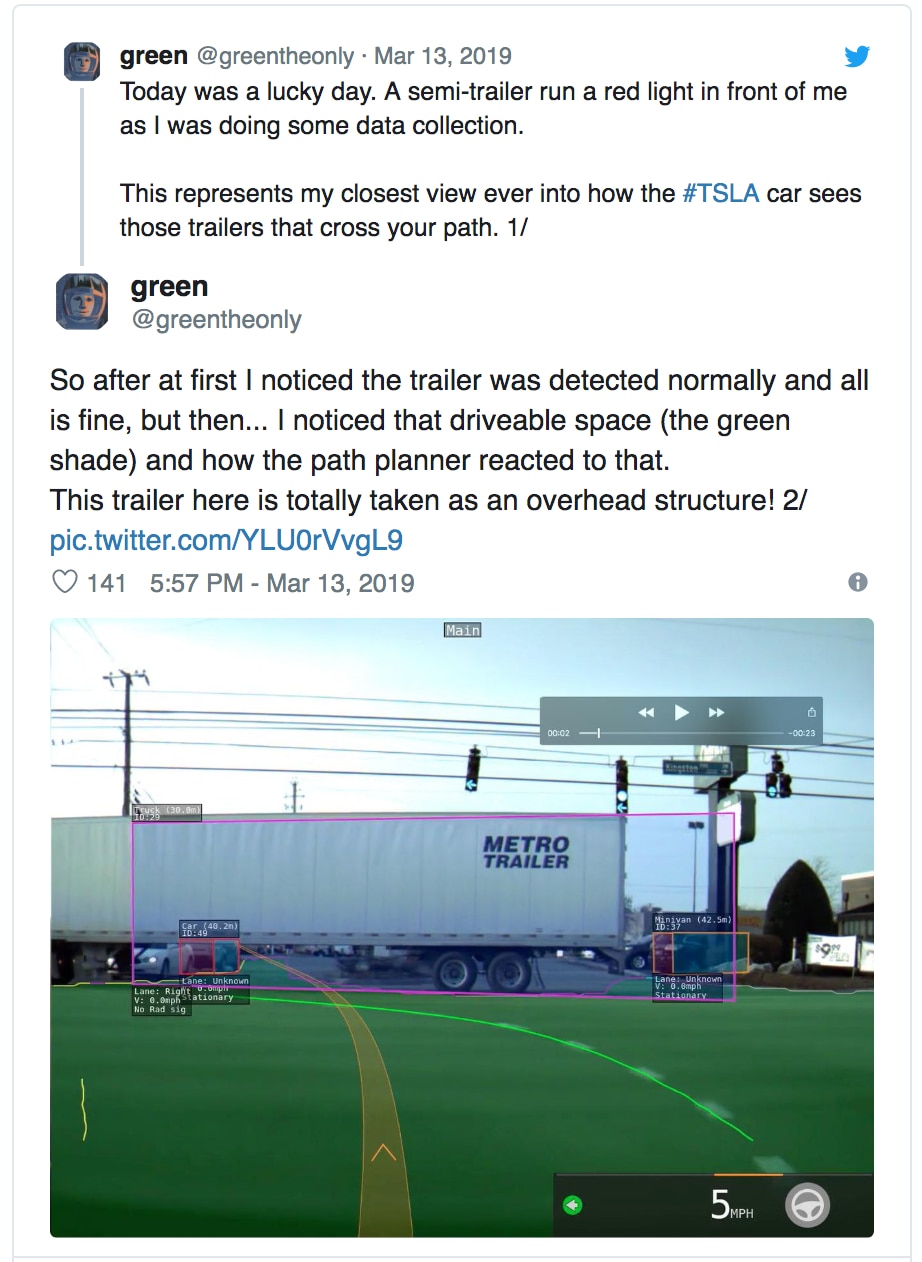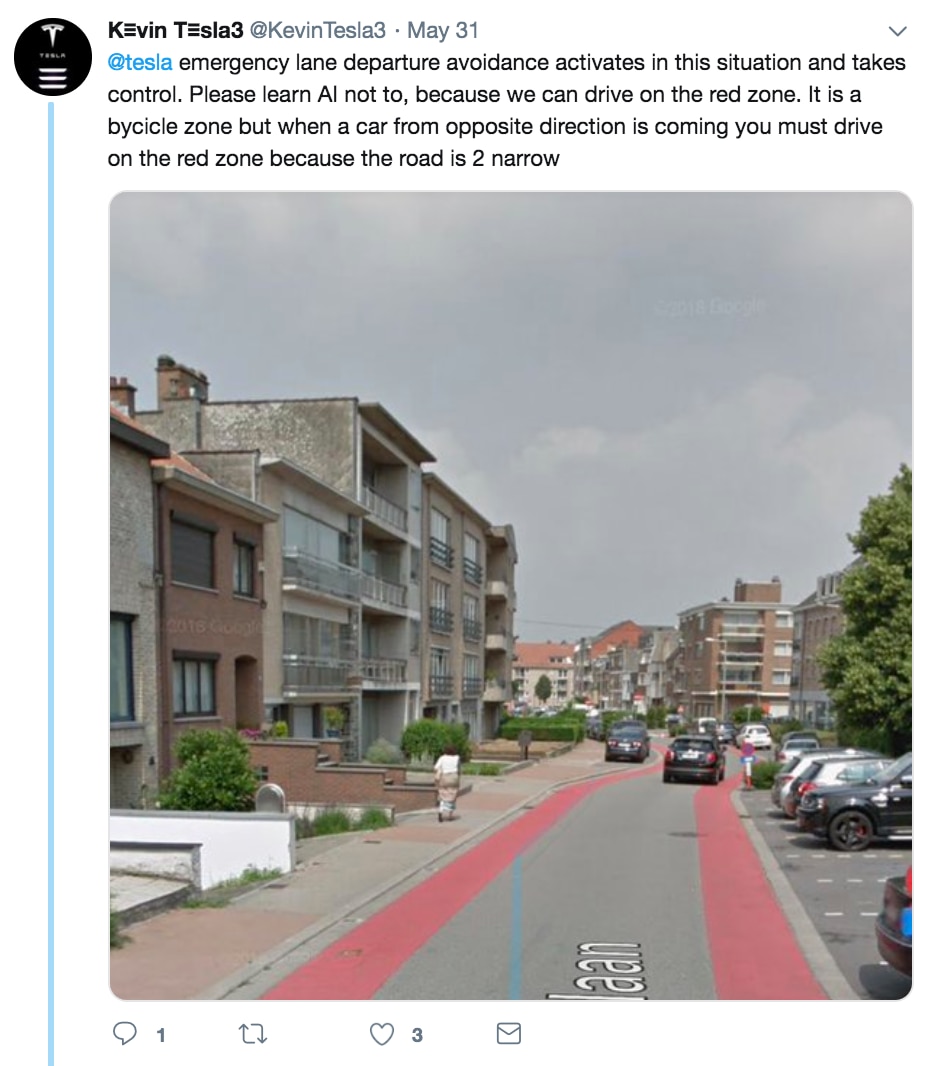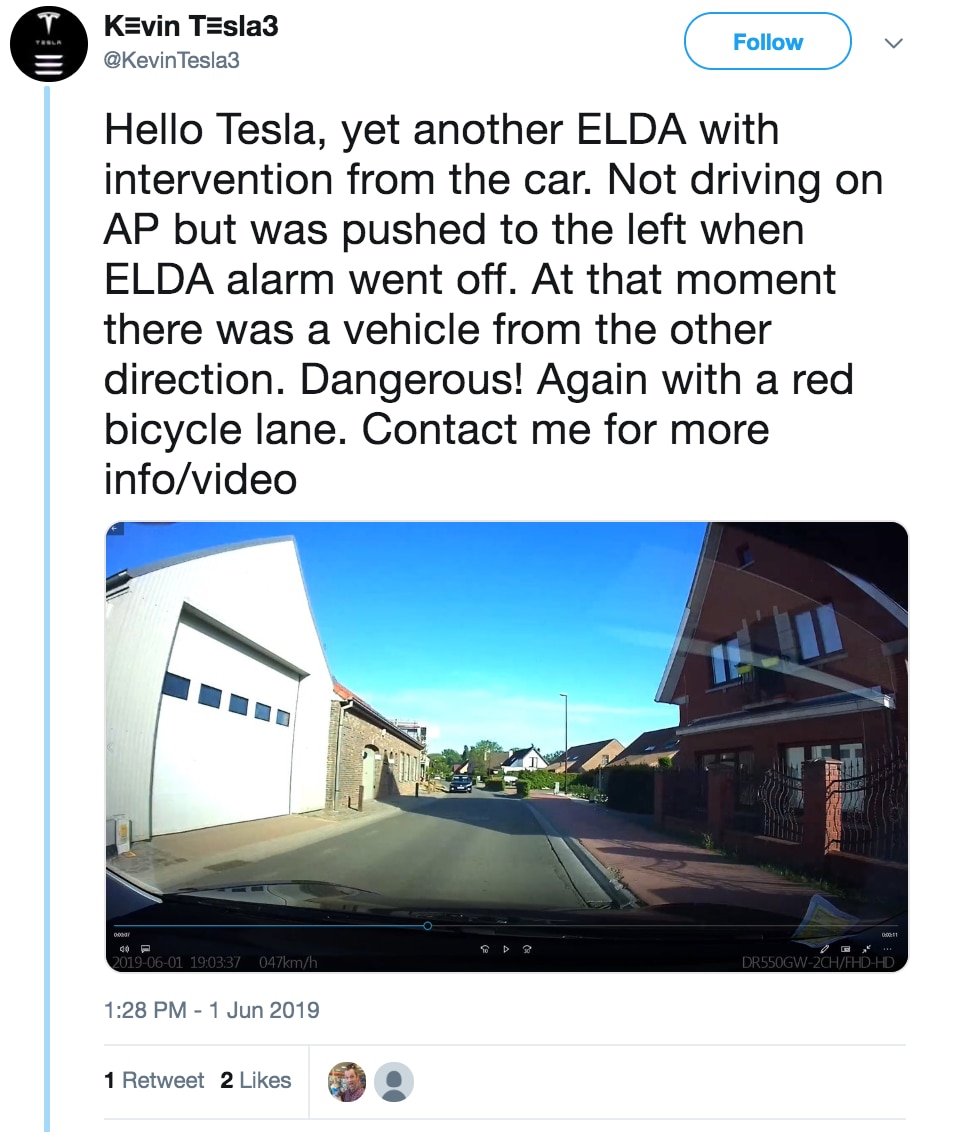Are you excited for this post? I certainly know
I am!
If this is the first article you're seeing of mine and you haven't read my prior article, "
Why Businesses Don't Want Machine Learning or Artificial Intelligence," I advise you go back and read it as a primer for some of the things I'm about to share here. You might get “edumicated,” or you might laugh. Either way, welcome.
Well, officially hello returning readers. And welcome to those who found their way here due to the power of SEO and the media jumping all over any of the applicable buzzwords in here.
The future is now. We’re literally living in the future.

Image: Tesla/YouTube
That's the word from the press rags if you've seen the
video of Tesla running on full autopilot and doing a complicated series of commute/drives cited in the article, "
New Video Shows Tesla's Self-Driving Technology at Work." And you would be right. Indeed, the future IS now. Well, kind of. I mean it's already a few seconds from when I wrote the last few words, so I'm clearly traveling through time...
But technology and novelty like driving in traffic are a little more nuanced than this.
"But I want this technology
right now. Look, it works. Stop your naysaying. You hate Tesla, blah blah blah, and so on."
That feels very much like Apple/Android fanboy or fan-hate when someone says anything negative about a thing they want/like/love. Nobody wants this more than me. (Well, except for the robots ready to kill us.)
Are There Really Self-Driving Teslas?
You might be surprised to know that Tesla has advanced significantly in the past few years. I know, imagine that—so much evolution! But just as we reward our robot overlords for stopping at a stop sign, they're only as good as the information we feed them.
We can put the mistakes of 2016 behind us with tragedies like this: "
Tesla self-driving car fails to detect truck in a fatal crash."
Fortunately, Tesla continues to improve and get better and we'll be ready to be fully autonomous with self-driving vehicles roaming the roads without flaw or problem by 2019. (Swirly lines, and flashback to just a few months into 2019:
Tesla didn't fix an Autopilot problem for three years, and now another person is dead.)
Is the Tesla Autopilot Safe?
Around this time, as I was continuing my study, research, and analysis of this and problems like it, I came across the findings of
@greentheonly.

Image:
https://twitter.com/greentheonly/status/1105996445251977217
And rightly so, we can call this an anomaly. This doesn't happen that frequently. It's not a big deal, except for when it does happen. Not only just when, but the fact that it does happen… whether it's seeing the undercarriage of a truck and interpreting it as an overpass and thus you can "safely pass" under it, shearing the top off of the cab, or seeing a truck to the side of you and interprets the space beneath the truck as a safe “lane” to change into.
But hey, that's Autopilot. We're not going to use that anymore until it's solid, refined, and safe. Then the AI and ML can't kill me. I'll be making all the decisions.


Image:
https://twitter.com/KevinTesla3/status/1134554915941101569
If you recall in the
last article, I mentioned the correlation of robots, Jamba Juice, and plasma pumps. Do you ever wonder why Boston Dynamics doesn't have robot police officers like the ED-209 working on major metro streets, providing additional support akin to RoboCop? (I mean, other than the fact that they're barely allowed to use machine learning and computer vision. But I digress.)
It’s because they're not ready yet. They don't have things fully baked. They need a better handle on the number of “faults” that can occur, not to mention liability.
Is Autonomous Driving Safe?
Does this mean, though, that we should stop where we are and no one should use any kind of autonomous driving function? (Well, partially...) The truth is, there are, on average,
1.35 million road traffic deaths each year. Yes, that figure is worldwide, but that figure is also insanely staggering. If we had autonomous vehicles, we could greatly diminish the number of accidents we experience on the roads, which could bring those death tolls down significantly.
And someday, we will get there. The vehicles’ intelligence is getting better every day. They make mistakes, sometimes not so bad—"Oh, I didn't detect a goose on the road as an object/living thing and ended up running it over." Or, "The road was damaged in an area, so we didn't detect that was a changing lane/crossing lane/fill-in-the-blank of something else."
The greatest strength of autonomous vehicles like Tesla, Waymo, and others is their telemetry. But their greatest weakness is their reliance solely on some points of telemetry.
Can Self-Driving Cars Ever Be Safe?
In present-day 2019, we rely on vehicles with eight cameras (hey, that's more eyes than us humans have!), some LIDAR data, and a wealth of knowledge of what we should do in conditions on roadways. Some complaints I've shared with various engineers of some of these firms are the limitations of these characteristics, mainly that the cameras are fixed, unlike our eyes.

Video:
https://youtu.be/SwfKeFA9iEo?t=22
So, if we should encounter a rockslide, a landslide, something falling from above (tree, plane, meteorite, car-sized piece of mountain, etc.) we'll be at the will of the vehicle and its ability to identify and detect this. This won't be that big of a deal, though. We'll encounter a few deaths here or there, it'll make the press, and they'll quietly cover it up or claim to fix it in the next bugfix released over the air to the vehicles (unlike the aforementioned problem that went unsolved for three years).
The second-biggest problem we face is, just like us, these vehicles are (for the most part) working in a vacuum. A good and proper future of self-driving autonomy will involve the vehicles communicating with each other, street lights, traffic cameras, environmental data, and telemetry from towers, roads, and other sensors. Rerouting traffic around issues will become commonplace. When an ambulance is rushing someone to a hospital, it can clear the roadways in favor of emergency vehicles. Imagine if buses ran on the roads efficiently. The same could be true of vehicles.
That's not a 2020 vision. It’s
maybe a 2035 or 2050 vision in some cities. But this is a future that can be well seen ahead of us.
The Future of Tesla and Self-Driving Vehicles
It may seem like I’m critical of Tesla and their Autopilot programs. That’s because I am. I see them jumping before they crawl. I've seen deaths rack up, and I've seen many VERY close calls. It's all in the effort of better learning and training. But it's on the backs of consumers and on the graves of the end users who've been made to believe these vehicles are tomorrow's self-drivers. In reality, they’re in an Alpha state with the sheer limited amount of telemetry available.
Will I use Autopilot? Yeah, probably... and definitely in an effort of discovering and troubleshooting problems because I'm the kind of geek who likes to understand things. I don't have a Tesla yet, but that's only a matter of time.
So, I obviously cannot tell you what to do, with your space-age vehicle driving you fast forward into the future, but I will advise you to be cautious. I've had to turn ELDA off on my Chevy Bolt as it has been steering me into traffic, and that effectively has little to nothing I would consider "intelligent" in the grand scheme of things.
At the start of this article, I asked if you were as excited as I was. I'm not going to ask if you're as terrified as I am! I will ask you to be cautious. Cautious as a driver, cautious as a road-warrior. The future is close, so let's see you live to see it with the rest of us. Because I look forward to a day where the
number 10 cause of death worldwide is a thing of the past.
Thank you and be safe out there!
 Image: Tesla/YouTube
That's the word from the press rags if you've seen the video of Tesla running on full autopilot and doing a complicated series of commute/drives cited in the article, "New Video Shows Tesla's Self-Driving Technology at Work." And you would be right. Indeed, the future IS now. Well, kind of. I mean it's already a few seconds from when I wrote the last few words, so I'm clearly traveling through time...
But technology and novelty like driving in traffic are a little more nuanced than this.
"But I want this technology right now. Look, it works. Stop your naysaying. You hate Tesla, blah blah blah, and so on."
That feels very much like Apple/Android fanboy or fan-hate when someone says anything negative about a thing they want/like/love. Nobody wants this more than me. (Well, except for the robots ready to kill us.)
Image: Tesla/YouTube
That's the word from the press rags if you've seen the video of Tesla running on full autopilot and doing a complicated series of commute/drives cited in the article, "New Video Shows Tesla's Self-Driving Technology at Work." And you would be right. Indeed, the future IS now. Well, kind of. I mean it's already a few seconds from when I wrote the last few words, so I'm clearly traveling through time...
But technology and novelty like driving in traffic are a little more nuanced than this.
"But I want this technology right now. Look, it works. Stop your naysaying. You hate Tesla, blah blah blah, and so on."
That feels very much like Apple/Android fanboy or fan-hate when someone says anything negative about a thing they want/like/love. Nobody wants this more than me. (Well, except for the robots ready to kill us.)
 Image: https://twitter.com/greentheonly/status/1105996445251977217
And rightly so, we can call this an anomaly. This doesn't happen that frequently. It's not a big deal, except for when it does happen. Not only just when, but the fact that it does happen… whether it's seeing the undercarriage of a truck and interpreting it as an overpass and thus you can "safely pass" under it, shearing the top off of the cab, or seeing a truck to the side of you and interprets the space beneath the truck as a safe “lane” to change into.
But hey, that's Autopilot. We're not going to use that anymore until it's solid, refined, and safe. Then the AI and ML can't kill me. I'll be making all the decisions.
Image: https://twitter.com/greentheonly/status/1105996445251977217
And rightly so, we can call this an anomaly. This doesn't happen that frequently. It's not a big deal, except for when it does happen. Not only just when, but the fact that it does happen… whether it's seeing the undercarriage of a truck and interpreting it as an overpass and thus you can "safely pass" under it, shearing the top off of the cab, or seeing a truck to the side of you and interprets the space beneath the truck as a safe “lane” to change into.
But hey, that's Autopilot. We're not going to use that anymore until it's solid, refined, and safe. Then the AI and ML can't kill me. I'll be making all the decisions.

 Image: https://twitter.com/KevinTesla3/status/1134554915941101569
If you recall in the last article, I mentioned the correlation of robots, Jamba Juice, and plasma pumps. Do you ever wonder why Boston Dynamics doesn't have robot police officers like the ED-209 working on major metro streets, providing additional support akin to RoboCop? (I mean, other than the fact that they're barely allowed to use machine learning and computer vision. But I digress.)
It’s because they're not ready yet. They don't have things fully baked. They need a better handle on the number of “faults” that can occur, not to mention liability.
Image: https://twitter.com/KevinTesla3/status/1134554915941101569
If you recall in the last article, I mentioned the correlation of robots, Jamba Juice, and plasma pumps. Do you ever wonder why Boston Dynamics doesn't have robot police officers like the ED-209 working on major metro streets, providing additional support akin to RoboCop? (I mean, other than the fact that they're barely allowed to use machine learning and computer vision. But I digress.)
It’s because they're not ready yet. They don't have things fully baked. They need a better handle on the number of “faults” that can occur, not to mention liability.
 Video: https://youtu.be/SwfKeFA9iEo?t=22
So, if we should encounter a rockslide, a landslide, something falling from above (tree, plane, meteorite, car-sized piece of mountain, etc.) we'll be at the will of the vehicle and its ability to identify and detect this. This won't be that big of a deal, though. We'll encounter a few deaths here or there, it'll make the press, and they'll quietly cover it up or claim to fix it in the next bugfix released over the air to the vehicles (unlike the aforementioned problem that went unsolved for three years).
The second-biggest problem we face is, just like us, these vehicles are (for the most part) working in a vacuum. A good and proper future of self-driving autonomy will involve the vehicles communicating with each other, street lights, traffic cameras, environmental data, and telemetry from towers, roads, and other sensors. Rerouting traffic around issues will become commonplace. When an ambulance is rushing someone to a hospital, it can clear the roadways in favor of emergency vehicles. Imagine if buses ran on the roads efficiently. The same could be true of vehicles.
That's not a 2020 vision. It’s maybe a 2035 or 2050 vision in some cities. But this is a future that can be well seen ahead of us.
Video: https://youtu.be/SwfKeFA9iEo?t=22
So, if we should encounter a rockslide, a landslide, something falling from above (tree, plane, meteorite, car-sized piece of mountain, etc.) we'll be at the will of the vehicle and its ability to identify and detect this. This won't be that big of a deal, though. We'll encounter a few deaths here or there, it'll make the press, and they'll quietly cover it up or claim to fix it in the next bugfix released over the air to the vehicles (unlike the aforementioned problem that went unsolved for three years).
The second-biggest problem we face is, just like us, these vehicles are (for the most part) working in a vacuum. A good and proper future of self-driving autonomy will involve the vehicles communicating with each other, street lights, traffic cameras, environmental data, and telemetry from towers, roads, and other sensors. Rerouting traffic around issues will become commonplace. When an ambulance is rushing someone to a hospital, it can clear the roadways in favor of emergency vehicles. Imagine if buses ran on the roads efficiently. The same could be true of vehicles.
That's not a 2020 vision. It’s maybe a 2035 or 2050 vision in some cities. But this is a future that can be well seen ahead of us.

